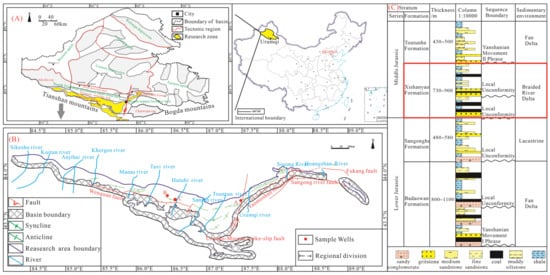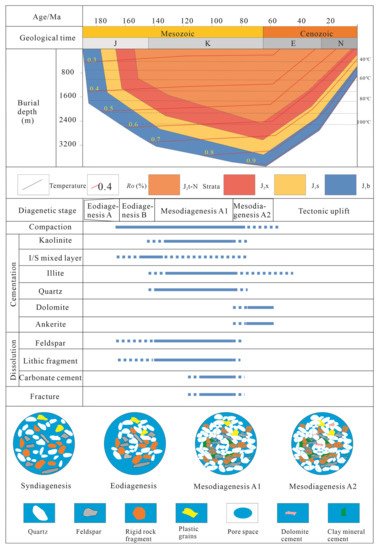The Junggar basin is located in the northern part of Xinjiang; it is a large-scale Mesozoic-Cenozoic depression basin with an area of about 13.4 × 10
4 km
2 and an approximately triangular shape in the plane, with a width of 1120 km from east to west and 800 km from north to south [
1,
2,
3]. Since the Late Paleozoic, the Junggar basin has experienced Hercynian, Indosinian, Yanshan and Himalaya tectonic movements, and the superposition of multi-phase stress fields has led to its structural complexity [
2,
44,
48]. The Junggar basin can be divided into six structural units: the Luliang uplift, the Ulungu depression, the northern Tianshan piedmont thrust belt, the western uplift, the central depression, and the eastern uplift [
3,
49] (
Figure 1A). The SJB is located in the northern Tianshan piedmont thrust belt, which elongates east-west direction with a north-south width of nearly 200 km (
Figure 1B). The northern Tianshan piedmont thrust belt is a multi-phase superimposed and inherited structural belt, and is usually divided into five secondary structural units, including the Sikeshu sag, Qigu fault–fold belt, Huomatu anticlinal zone, Huan anticlinal zone, and Fukang fault zone [
50].
3. Paragenetic Sequence of Coal Measure Sandstone Diagenesis
3.1. Determination of Diagenetic Stage
The clarification of diagenetic stages should be based on paleo-temperature (T), vitrinite reflectance (Ro), maximum pyrolysis peak temperature (Tmax), and smectite mixed layer ratio (S%) of I/S, spatial and temporal assemblages of authigenic minerals and the contact relationships between particles [
5,
22,
67]. The Ro of coal measure shale in the Xishanyao formation in the study area ranges from 0.63–0.89%. The clay minerals of the coal measure sandstone are dominated by I/S, kaolinite and illite, with the mixed layer ratio (S%) of I/S ranging from 10–30% (avg on 18%). The compaction strongly influences the coal measure sandstone, with contact relationships composed of line contact, concave-convex contact, and suture contact. The reconstructed thermal history of the Jurassic strata, which is conducted by Wang et al.[
68], found that the maximum burial depth of the Xishanyao formation exceeded 3000 m and the paleotemperature exceeded 100 °C. According to the diagenetic stage classification standard of clastic rocks (China’s oil and gas industry standard SY/T5477-2003), it can be comprehensively determined that the diagenetic stage of the Xishanyao formation coal measure sandstone is in the mesodiagenesis A1 and A2 stage (
Figure 2).
3.2. Diagenetic Sequences of Coal Measure Sandstone
Combining with the thermal and burial history of the SJB, referring to the division of diagenetic stages in clastic rocks of China’s oil and gas industry standard SY/T5477-2003, the diagenetic evolution of the Xishanyao formation coal measure sandstone in the area is summarized as follows:
In this stage, the diagenetic environment has not been completely disconnected from the overlying water. The organic matter deposited in the peat swamp generates CO2 under the action of microorganisms and dissolves in water, making the diagenetic environment weakly acidic. Due to the acidic nature of the sedimentary water, the surface of the detrital particles is rarely coated by a chlorite clay film. Due to the strong hydrodynamic environment during the sedimentary period, the coal measure sandstone contains a certain amount of plastic micrite carbonate and carbonaceous fragments will be blended into the sandstone.
The type and degree of diagenesis in the eodiagenesis stage will affect the type of diagenesis and the physical properties of the reservoir in the later diagenetic stage [
22]. At this stage, the diagenetic environment is weakly acidic, and the diagenesis types include mechanical compaction, cementation (mainly argillaceous cementation) and dissolution, and the diagenetic environment gradually changes to a closed system. The compaction significantly reduces primary porosity [
69,
70], due to the shallow burial depth and the high subsidence rate. The rock is in a weakly consolidated and semi-consolidated state, and the contact relationships of the clastic particles change from point contact to point-line contact. Pore types of the coal measure sandstone in this stage are mainly primary pores, and a small amount of micrite carbonate cement fills the pores.
With the increase in temperature, the coal seams and dark shale gradually released organic acid and CO
2 [64], which makes the diagenetic environment gradually change to a weak acid. The feldspar and detrital grains began to dissolve slightly and form dissolution pores
(Figure 2).
Figure 2. The paragenetic sequence and pore evolution of the Xishanyao formation in the SJB. The thermal evolution history is based on the study of Wang et al. [
68] with some modifications. Solid blue lines represent probable timing based on observed diagenetic and mineralization phases. While the dashed blue lines represent inferred or not well-constrained diagenetic and mineralization phases. J
2x = Xishanyao formation; I/S = illite/smectite; Ro = vitrinite reflectance.
The effect of compaction in the mesodiagenesis A stage was extremely strong, and the compaction type gradually shifted from mechanical compaction to chemical compaction. The contact relationships change from point contact and line contact to line contact, concave–convex contact and suture contact during this stage, along with a large proportion of brittle minerals broken up. The dissolution pores formed in the eodiagenesis stage are damaged under the compaction, and the damage of compaction to the quality of the reservoir is further strengthened. The mesodiagenesis A stage can be further divided into two substages, A1 and A2, according to temperature and Ro. These two substages have certain differences in diagenetic environment and diagenetic reaction:
In the mesodiagenesis A1 stage, the temperature was 70–90 °C, and the Ro was 0.5–0.7%, in an acidic diagenetic environment. The amount of organic acid generated in coal measures reaches the highest level at this temperature [
71], the diagenetic environment is acidic, and the tensity of dissolution reached the highest level (
Figure 2). The massive dissolution of feldspar, aluminosilicate lithic fragments and early micrite carbonate cement formed a large number of dissolution pores and mould pores. Because of the relatively closed diagenetic system, the dissolution products cannot be discharged. This has led to the kaolinite filling pores and quartz overgrowth (part of the SiO
2 comes from the chemical compaction).
In the Mesodiagenesis A2 stage, the temperature was 90–130 °C, and the Ro was 0.7–1.3%. The acidic diagenetic environment is gradually weakened due to the decomposition of organic acids. The effect of dissolution decreases gradually, while the cementation gradually increases. The quartz overgrowth gradually decreases, which is manifested as second level quartz cementation. Late period carbonate cementation (dolomite and ankerite) gradually filled the pore space (Figure 2). The clay minerals appear abundantly and fill the pores, further reducing the porosity.
4. Diagenetic Control of Coal Measure Reservoir Quality
Reservoir quality is influenced by diagenetic activities, such as compaction, cementation, dissolution, recrystallization, and metasomatism [
20,
72]. For the Xishanyao formation coal measure sandstone, compaction, dissolution and cementation are the main diagenetic controlling factors for reservoir quality.
4.1. The Influence of Compaction on Reservoir Quality
Compaction is one of the main factors that cause the reduction of intergranular pore volume [
73] and the densification of coal measure sandstone reservoirs. Plastic particles in the sandstone have a weak compaction resistance, while the rigid particles have a high compaction resistance ability [
61,
74]. The coal measure sandstones of the Xishanyao formation contain a high content of plastic grains, such as volcanic lithic fragments, muddy gravel and carbonaceous fragments, which makes its compaction resistance ability weak.
The coal measure sandstone reservoirs are strongly affected by mechanical compaction, which is characteristic of the close contacted clastic particles, the ruptured rigid particles, and the deformed plastic particles. Chemical compaction commonly happens in SJB due to the high intensity of compaction, which may lead to particle suture contact and reduced interparticle space. The intense mechanical and chemical compaction has a great negative effect on the physical properties of the sandstone reservoir.
4.2. The Influence of Cementation on Reservoir Quality
The coal measure sandstone of the Xishanyao formation in the SJB is mainly clay mineral cement, followed by quartz cement and carbonate cement. The development of these cementations is one of the main factors leading to the significant decline in reservoir quality [
74,
75,
76,
77].
The closed diagenetic system of coal measure sandstone prevents the dissolution products from being discharged in time, which also leads to the development of authigenic kaolinite cementation and quartz cementation. The developed kaolinite cement fills the pore space in large quantities, but its loose inter-crystalline structure contains inter-crystalline pores that can resist compaction [
78]. In addition, illite and I/S mainly fill intergranular pores and pore throats, thereby reducing the reservoir quality of the sandstone [
65,
79,
80]. In summary, different types of clay minerals occur widely and fill or divide the pore space, resulting in tortuous pore throats, reducing pore connectivity, and weakening seepage capacity [
13,
37,
65,
79,
80].
The content of volcanic lithic fragments in coal measure sandstone is relatively high, which may inhibit the quartz overgrowth to some extent [
77]. It can be observed that the overgrowth level of the coal measure sandstone is shown in the second stage. The quartz overgrowth in the eodiagenesis stage can help the sandstone better resist compaction. In the mesodiagenesis, pressure solution, feldspar dissolution and clay mineral transformation produced many SiO
2 (aq), which developed into quartz cement [
13,
81,
82].
The carbonate cement is locally developed in coal measure sandstones. In the eodiagenesis stage, several micrite carbonate particles blended in the coal measure sandstone, which blocked and filled the intergranular pores. In the mesodiagenesis A2 stage, the late period dolomite and ankerite cements appeared in the sandstone, which blocked the intergranular pores of the sandstone and reduced the reservoir quality.
4.3. The Influence of Dissolution on Reservoir Quality
The dissolution in diagenesis has a positive effect on reservoir physical properties [
13]. The coal seam and dark shale begin to produce organic acids through the decomposition of plant residues during the eodiagenesis stage [
71] and reach a peak in the mesodiagenesis stage (temperature range from 80 °C to 140 °C, [
37,
83]). The amount of organic acid generated in the coal measure is much higher than in other source rocks [
5,
7,
84].
The sedimentary environment makes the sandstone have good primary physical properties and pore connectivity, and the weak dissolution in the eodiagenesis stage provides a seepage channel for the migration of acidic fluids in the mesodiagenesis stage. The large proportion of aluminosilicate minerals, such as feldspar and volcanic in coal measure sandstone provides a good material basis for the dissolution [
5]. Dissolution is most intense in mesodiagenesis. During this period, the thermal evolution of organic matter releases a large number of organic acids into the diagenetic system of the sandstone, causing the soluble minerals to selectively dissolve and form a large number of intragranular dissolved pores and intergranular dissolution pores [
35]. Overall, the diagenetic stage of the coal measure sandstone in this area is mainly in the A1 and A2 stages of the mesodiagenesis, which happens to be the most intense stage of organic acid dissolution. The dissolution has brought a great positive effect on the physical properties of the reservoir.







